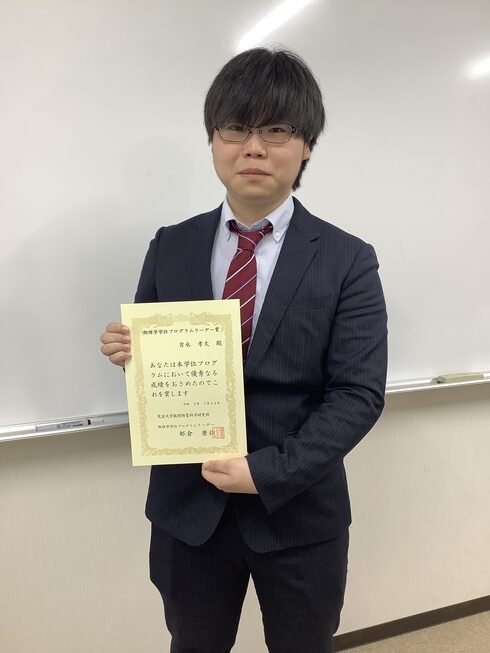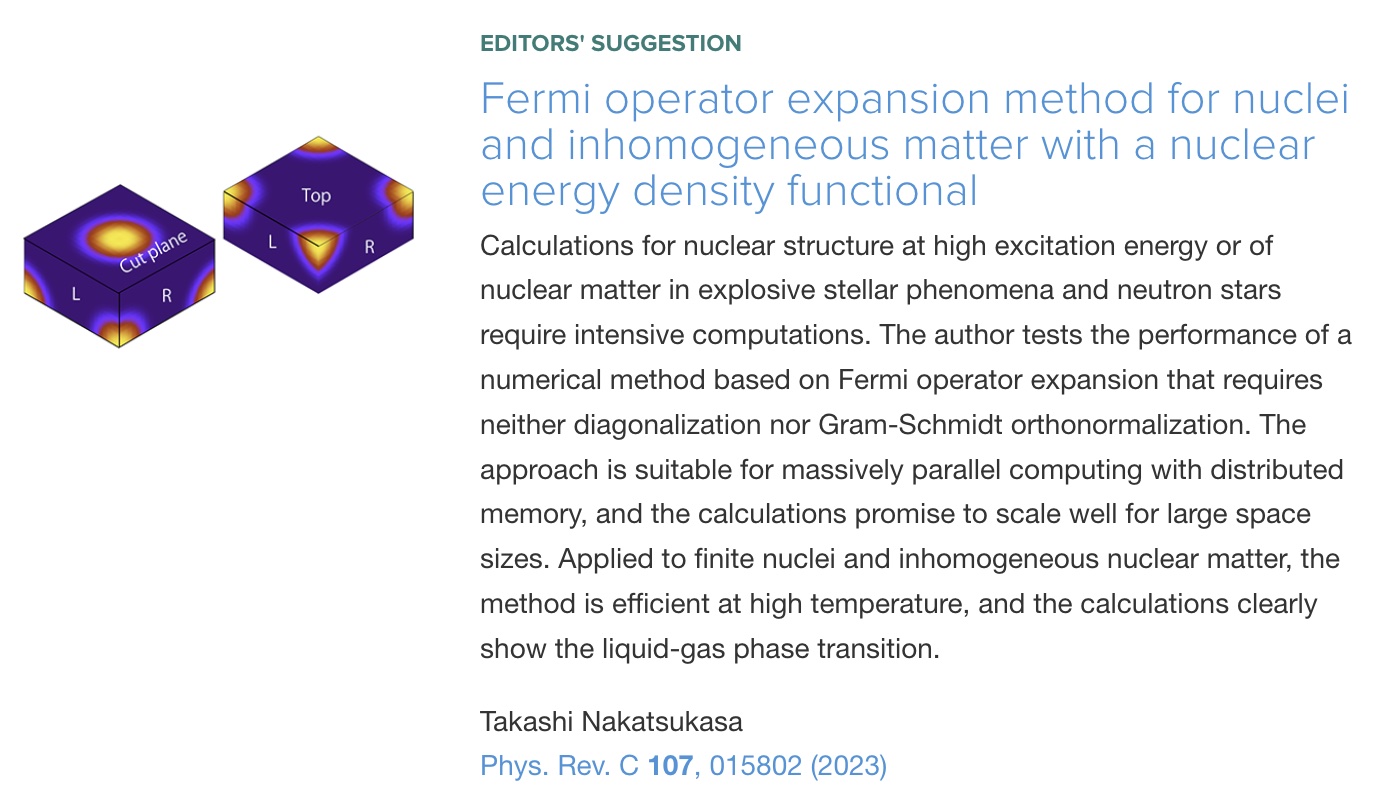Tsuchida-san and Yoshinaga-san got Msc degree; Hagihara-san, Kanai-san, Ruike-san got Bsc degree 修士取得(土田さん、吉永さん)、学士取得(萩原さん、金井さん、類家さん)
2023年3月24日 | 新着情報
Mr Tsuchida and Mr Yoshinaga have been awarded the Master degree of Science on March 24th, 2023. Mr Hagihara, Mr Kanai, and Ms Ruike have been awarded the Bachelor degree of Science on March 24th, 2023.
土田さん、吉永さんが修士(理学)を取得しました。また、萩原さん、金井さん、類家さんが学士(理学)を取得しました。
Ruike-san got Best Presentation Award in College of Physics; 物理学類ベストプレゼンテーション賞受賞(類家さん)
2023年2月18日 | 新着情報
The graduation research presentation (2023.2.1) by Ms Chisato Ruike has been selected as “Best presentation award“. It is on moments of inertia for the pairing rotation in nuclei, which will be shown in a bulletin board in the first floor of Building 1C.
4年生の類家さんの卒業研究発表(2023年2月1日)が「ベストプレゼンテーション賞」に選ばれました。研究は原子核対回転の慣性能率に関する内容で、1C棟1階の掲示板にポスターとして掲示される予定です。
ハイライト論文に選定 A paper selected as Editors’ Suggestion
2023年1月10日 | 新着情報
A paper by T. Nakatsukasa has been published in Physical Review C of American Physical Society, and selected as an Editors’ Suggestion. The paper proposes a computational method for the finite-temperature density functional calculations for finite nuclei and inhomogeneous nuclear matter.
有限温度における原子核と非一様核物質に対する密度汎関数計算の手法に関する論文(著者:中務)が、アメリカ物理学会のPhysical Review Cに出版され、Editors’ Suggestionに選ばれました。
Seminar (セミナー)2022.11.17 Miyagi, Takayuki (TU Darmstadt)
2022年11月11日 | 新着情報
The following seminar by Dr Miyagi (TU Darmstadt) will be held on November 17th, 2022. The language is Japanese.
Lecturer : Takayuki Miyagi (TU Darmstadt)
Place: Workshop Room (first floor), Center for Computational Sciences
Date/Time: Nov 17 (Thur), 15:00 PM
Title: Neutron skin of 208Pb from first principles
abstract:The neutron skin thickness could be crucial to constrain the nuclear equation of state (EoS). According to the mean-field type studies, the neutron skin of 208Pb is known to be strongly correlated with the slope parameter of the neutron matter EoS, motivating neutron skin thickness measurements. From this background, an ab initio study can be a good test of the correlation. Furthermore, it is interesting to see if the ab initio calculations can narrow down and predict the neutron skin. With the recent progress in the ab initio theory, such as underlying nuclear interaction, uncertainty quantification, and emulator technique, predicting the neutron skin of 208Pb becomes feasible. In this talk, I will introduce the recent progress and show the prediction for the neutron skin of 208Pb.
Language: Japanese (日本語)
Lecture (講義) 2022.10.11, Dr Morten Hjorth-Jensen (Oslo/MSU)
2022年9月28日 | 新着情報
A series of lectures are delivered by Prof. Hjorth-Jensen (Oslo/MSU) as follows:
Date/Time: 10:00 am – 15:30 pm, October 11th (Tue), 2022
Place: Workshop Room, Center for Computational Sciences, University of Tsukuba
Lecturer: Dr Morten Hjorth-Jensen (Oslo Univ. / Michigan State Univ.)
Title: From Linear Algebra to Machine Learning: Ten Central Algorithms for Studying Quantum Mechanical Many-Particle Problems
Abstract: In this series of lectures we outline central algorithms for studying quantum mechanical systems, with an emphasis on both computational and pedagogical aspects. Using simple systems that allow for analytical solutions, we show how one can move from linear algebra and eigenvalue algorithms using for example full configuration interaction theory, to stochastic methods like variational and Diffusion Monte Carlo approaches and finally, how we can use Monte Carlo methods together with deep learning algorithms. Along this journey we will present ten central algorithms which have changed considerably the way we study interacting many-particle systems. These algorithms span from Householder’s famous transformation of matrices, via iterative eigenvalue solvers to neural networks and automatic differentiation for optimizing multidimensional functions. Codes and jupyter-notebooks are provided, allowing thereby people to experiment and practice the various methods.
This lecture is given in English.
オスロ大・ミシガン州立大のHjorth-Jensen氏による量子多体系及び機械学習に関する講義を以下の日程で実施します。なお、この講義は英語で行います。
日時:2022年10月11日(火)、10:00 ー 15:30
場所:筑波大学計算科学研究センター 1F, 国際ワークショップ室
題目・概要等は上記を参照。
小澤さん、修士取得 Ozawa-san got Msc degree
2022年9月22日 | 新着情報
Mr. Ozawa has been awarded the Master degree of Science on September 22nd, 2022.
2022年9月22日、小澤さんが修士号を取得しました。
集中講義 宇都野氏(JAEA), Lectures by Dr Utsuno (JAEA) 2022.9.20-22
2022年9月1日 | 新着情報
A series of lectures will be delivered by Dr Utsuno (JAEA) as follows:
Progress in nuclear structure research using large-scale shell-model calculations”
Lecturer: Utsuno, Yutaka (JAEA)
Time/Dates: Sep. 20 (Tue) 10:30-16:30, Sep. 21 (Wed) 10:30-16:30, Sep. 22 (Thu) 10:30-15:00
Place: Meeting Room A, Center for Computational Sciences, University of Tsukuba
This lecture is given in Japanese.
題目: 大規模殻模型計算による原子核構造研究の進展
講師: 宇都野 穣 氏 (日本原子力研究開発機構・研究主席)
9月20日(火) 10:30 ~ 16:30
9月21日(水) 10:30 ~ 16:30
9月22日(木) 10:30 ~ 15:00
場 所: 計算科学研究センター会議室A
概要:殻模型は約70年前に原子核の一粒子模型として誕生した後、配位混合として多体相関を取り込んだ理論へと発展した。当初は閉殻近傍の限られた原子核しか取り扱えなかったが、大規模数値計算手法の発展に伴い、軽い核では数値対角化手法により1主殻を完全にカバーし、重い核でもモンテカルロ殻模型計算などの新手法によってそのフロンティアが拡大している。本講義では大規模殻模型計算の発展について、手法的な側面と現実的な核構造計算の側面の両方からわかりやすく解説する。
Seminar (セミナー)2022.9.1 Jon Kristian Dahl (Oslo Univ.)
2022年8月31日 | 新着情報
The following seminar will be given by Jon Kristian Dahl (Oslo University, Norway), who is visiting our group in Aug. 29-Sep.2, 2022.
Title: Investigating the low energy enhancement of scandium-44, vanadium-50, and vanadium-51 with large-scale shell model calculations
Date/Place: 11:00-12:00, Sep. 1st, 2022 / Workshop room, CCS 1F
Abstract: We live in a time where computational power is growing rapidly and is widely accessible. Large-scale shell model (LSSM) calculations are computationally heavy and benefit greatly of today’s supercomputers, making calculations which were not possible just a few years ago feasible today. Shell model calculations have historically been used to calculate the few lowest lying energy levels of nuclei, but with today’s computing power we are able to calculate thousands of energy levels and millions of transitions between the levels, opening doors to new and improved statistical analyses of LSSM calculations.
The low energy enhancement (LEE) is a feature of the gamma strength function (GSF) which was experimentally discovered by Emel Tavucku in 2002. Tavucku found that the GSFs of iron-56 and iron-57 had unexpected enhancements at the lowest gamma energies, which means that their probability of decaying as a function of gamma energy increases as the gamma energy approaches zero. The LEE has since been found in many other nuclei. It’s discovery came as a great surprise because it did not fit with any of the current models. With today’s computing power, LSSM calculations help us understand the origin of the LEE and may give important insight to the consequences of having an increased probability of decay by low energy gamma rays.
In this presentation, the GSFs of scandium-44, vanadium-50, and vanadium-51 from LSSM calculations will be discussed, with an emphasis on the LEE. The LSSM calculations were performed with the code “KSHELL”, and they will be compared to experimental data obtained with the Oslo method at the Oslo Cyclotron Laboratory. A short introduction to the generalized Brink-Axel (gBA) hypothesis will be presented, as well as a statistical approach of analysing the gBA hypothesis with the Porter-Thomas distribution.



